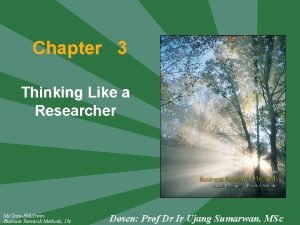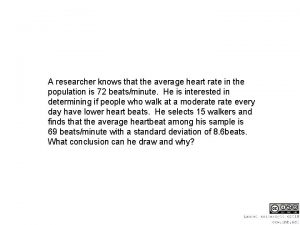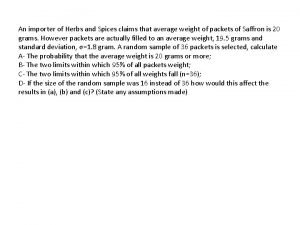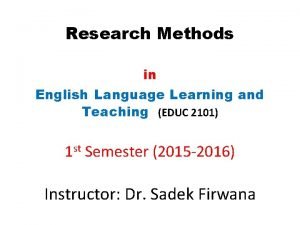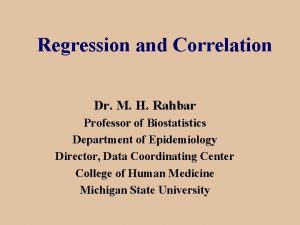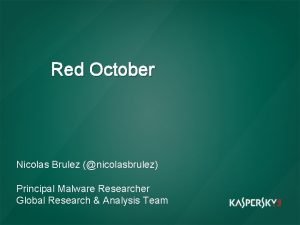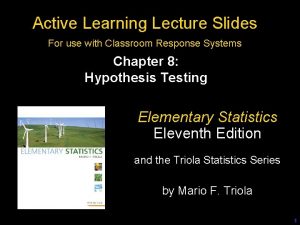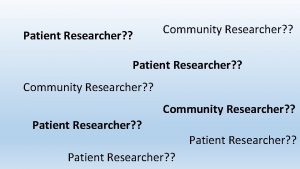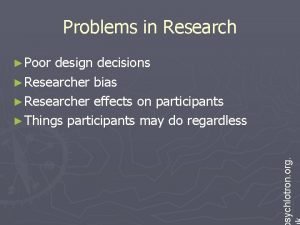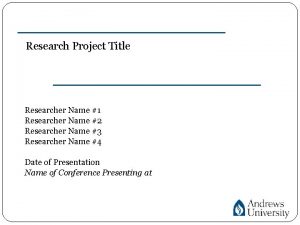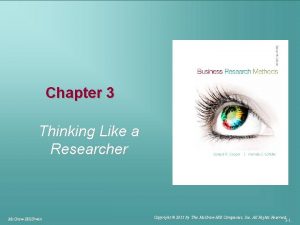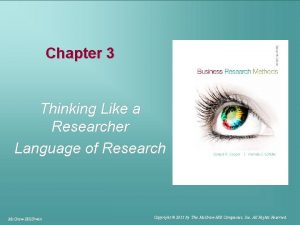Thinking like a Researcher Research Methods Fall 2015
























- Slides: 24

Thinking like a Researcher Research Methods Fall 2015 September 8 th

Overview Units of Analysis: what/who to research Sampling: finding what/who Variables: defining & measuring what/who Stats: analyzing what/who

Units of Analysis Units of Analysis: the person, collective or object being studied AKA What or whom is being studied Typical units of Analysis Individual Group Organization/Firm Social Interaction/Event Social Artifacts Neighborhood

Individuals Must choose a population of individuals to study Individuals should be similar in some way Females, Prison inmates, Gays & Lesbians, Residents of a specific place/neighborhood, Police officers If individuals are the unit of analysis: Descriptive studies aim to describe characteristics of the population to which the individuals belong Explanatory studies aim to discover the social dynamics operating within that population

Groups Social groups can be units of analysis Interested Example: Study Other in characteristics that belong to one group investigate social differences between gangs various gangs (groups) to understand differences examples: Families/households Couples Cities Professions

Organizations Organizations: groups of individuals brought together in a formal manner Corporations Social service agencies Police precincts Government offices/divisions Research multiple groups or organizations in order to compare and contrast Gather and compare data about each group or organization not the individuals within them


Social Interactions/Events Study the interactions between individuals Board room meetings, Homicides, traffic accidents, riots, weddings, twitter conversations The unit of analysis is the action component What Can was said in meeting, tweets, murders, etc. also study a social artifact Any product or creation of social beings or their behavior Examples: books, laws, buildings, job types How many laws contain language that…

Units of Analysis Activity For each excerpt, name the unit of analysis and identify the type of unit A. Women watch TV more than men because they are likely to work fewer hours outside the home than men. B. Of the 130 incorporated US cities with more than 100, 00 inhabitants in 1960, 126 had at least two short-term nonproprietary general hospitals. C. The early Transcendental Meditation organizations were small and informal. The LA group, begun in June 1959, met a member’s house. D. However, it appears that the nursing staffs exercise strong influence over…a decision to change the nursing care system.

Units of Analysis Activity A. Though 667, 000 out of 2 million farmers in the US are women, women historically have not been viewed as farmers but rather as the farmers wife. B. The analysis of community opposition to group homes for the mentally handicapped…indicates that deteriorating neighborhoods are most likely to organize in opposition, but that upper-middle class neighborhoods are most likely to enjoy private access to local officials. C. This paper examines variations in job title structures across work roles. Analyzing 3, 173 job titles in the California civil service system in 1985…

Finding the Units of Analysis Population: group of people/events researchers are interested in researching Example : Transgender Inmates Sample: smaller subject of people/groups/event used in order to conduct research Sampling: assembling and reaching out to this smaller subset to conduct research Transgender inmates in the NY prison system

Probability Sampling Probability sampling: using random selection to create sample Every person in your population must have equal chance to be chosen in the study Probability sampling relies on probability theory Branch of math that allows research to statistically analyze the results of their sampling All large scale surveys use probability sampling Ensures that your sample is representative of the whole population that you are studying

Nonprobability Sampling Nonprobability sampling: a sampling technique used when sample is not selected randomly Relies on samples that you choose or that are easy to reach Used more often when you are looking for a specific population More common in social science research Inmates, police officers, criminal offenders, immigrants

Types of Nonprobability Sampling Available subjects: Relying on available subjects Data often not generalizable Cheap and easy Example: Participating in research studies in Psych 101 Gives researchers a starting point for larger studies

Types of Nonprobability Sampling Purposive Sampling: Researcher selects sample based on their knowledge of that population and purpose of the study AKA judgmental sampling: Units selected on the basis of the researcher’s knowledge Find individuals who fit the criteria you are interested in Examples: Student leaders, Right-wing individuals, Inmates in solitary confinement, Immigrants from Africa

Types of Nonprobability Sampling Snowball sampling: Gather a sample by conducting interviews and following leads to new individuals or groups Employed in field research Each person you interview may give you leads to another person to interview and so on Can illuminate connections between people, groups, and organizations

Types of Nonprobability Sampling Selecting Informants: find someone well-versed in the social phenomenon that you wish to study Different from respondent – just someone who answers survey or interview questions without prior knowledge This sampling technique is good if you are trying to learn about a specific (and maybe hard-to-access) social phenomenon/interaction Example: corruption, social networks in neighborhoods

1. Once you have found what/who to study Units of Analysis Sample 2. Must figure HOW to study them Need to ask: what am I measuring? AKA How do you define your variables?

Variables: Part 1 Variable: a quantity or quality that varies across people or situations Quantitative variable: quantity that is measured by a number (i. e. height) Categorical variable: Quality that is measured by assigning a category label (i. e. eye color) How do you define your variables? Need to ask: what am I measuring?

Variables: Part 2 Variable: a measurable representation of an abstract construct (an idea created to explain a phenomenon) Example: Personality; Coping skills Concept: characteristics/attributes associated with objects, events, or people Extroversion; Seeking social support Example: • • Variable: Social Class Concepts/Attributes: Upper, middle, lower classes

Defining Variables How do you define your variables? Need to ask: what am I measuring? Operational definition: definition of the variables in terms of exactly how it will be measured. Example: Aggression

Homework 1. Find a recent news article about the topic you want to focus on for your research proposal. 2. Print the news article. Write a short summary (100200 words). 3. Define/Outline: a possible research question. the unit of analysis. possible variables.

Units of Analysis & Variables White males who receive plea bargains Treatment of Transgender individuals in prisons Economic inequality in New York City Police Brutality rates, reporting, and gender Legalization of Marijuana in CO Human trafficking of females age 17 -25 in Cambodia Gentrification in Brooklyn neighborhoods BLM movement awareness

Variables: Part 3 When looking for statistical relationships: Independent Cause, Variables explain other variables X Dependent variables are explained by other variables Effect, Y Changes in the independent variable (X) causes changes in (effects) the dependent variable (Y)
 Think like a researcher
Think like a researcher Thinking like a researcher
Thinking like a researcher Research impact and researcher identity
Research impact and researcher identity Fall protection methods
Fall protection methods Wax pattern in dentistry
Wax pattern in dentistry Types of educational research
Types of educational research A consumer confidence researcher asks several retailers
A consumer confidence researcher asks several retailers Contrived and non contrived
Contrived and non contrived Cs_rs 12-ia-c-1
Cs_rs 12-ia-c-1 Mga katangian na dapat taglayin ng isang mananaliksik
Mga katangian na dapat taglayin ng isang mananaliksik American researcher who involved in getting heart rate
American researcher who involved in getting heart rate Effective researcher
Effective researcher Elements of research design
Elements of research design A researcher claims that the average wind speed
A researcher claims that the average wind speed Active researcher
Active researcher Qualitative research methods
Qualitative research methods A researcher believes that there is a linear relationship
A researcher believes that there is a linear relationship Malware researcher
Malware researcher A researcher decides to study cognitive changes
A researcher decides to study cognitive changes A medical school claims that more than 28
A medical school claims that more than 28 Positive thinking vs negative thinking examples
Positive thinking vs negative thinking examples Thinking about your own thinking
Thinking about your own thinking Linear thinking vs holistic thinking
Linear thinking vs holistic thinking Perbedaan critical thinking dan creative thinking
Perbedaan critical thinking dan creative thinking Thinking about you thinking about me
Thinking about you thinking about me
